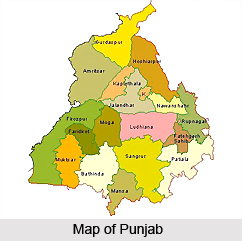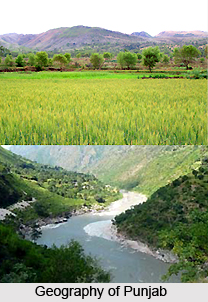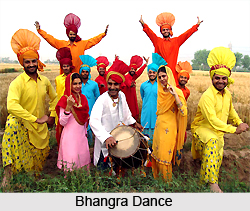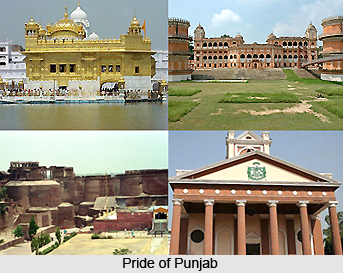 Punjab is one of the states in northern India that is known for its rich history and deep cultural heritage. The Greeks referred to Punjab as "Pentapotamia" that means an inland delta of five converging rivers. In Avesta, the holy text of Zoroastrians, the Punjab region is associated with the ancient Sapta Sindhu that is "the Land of Seven Rivers".
Punjab is one of the states in northern India that is known for its rich history and deep cultural heritage. The Greeks referred to Punjab as "Pentapotamia" that means an inland delta of five converging rivers. In Avesta, the holy text of Zoroastrians, the Punjab region is associated with the ancient Sapta Sindhu that is "the Land of Seven Rivers".
Punjab is bordered by Pakistan and the states of Jammu and Kashmir, Himachal Pradesh, Haryana and Rajasthan. The people speak Punjabi language. This heroic land bore numerous invasions, and after all its suffering, did not entirely lose its glory and its strength.The Harappan civilization developed in Punjab and its culture spread to Iran, Afghanistan, Baluchistan, and North Western parts of South Asia.
History of Punjab
The region has been invaded and ruled by many different empires and races, including the Aryans, Persians, Greeks, Egyptians, Afghans, and Mongols. Punjab is the cradle of the Indus Valley Civilization, more than 4000 years old. Archaeological excavations, throughout the state, have revealed evidences of the magnificent cities of Harappa and Mohenjodaro that existed along the banks of the mighty Indus River and its tributaries. Mahabharata, which narrates life between the 7th and 5th centuries BC, contains rich descriptions of the land and people of Punjab at that time.
 Around the time of the 15th century, Guru Nanak founded the Sikh religion, which quickly came to prominence in the region, and shortly afterwards, Maharaja Ranjit Singh reformed Punjab into a secular and powerful state.
Around the time of the 15th century, Guru Nanak founded the Sikh religion, which quickly came to prominence in the region, and shortly afterwards, Maharaja Ranjit Singh reformed Punjab into a secular and powerful state.
The 19th century saw the beginning of British rule in India, which led to the emergence of several heroic freedom fighters like Lala Lajpat Rai, Maharaja Ajit Singh, Bhagat Singh, Uddham Singh, Chandrasekhar Azad Rajguru, Sukdeva and many other unsung heroes. In 1947, after the independence, the Punjab was split between Pakistan and India. Since independence, life in Punjab proves to be tragic and traumatic. The partition resulted in riots and terror, which tore up millions of homes and destroyed many lives.
Geography of Punjab
Most of the region in Punjab is an alluvial plain, bounded by mountains in the north. Despite its dry conditions, it is a rich agricultural area due to the extensive irrigation made possible by the great river system traversing it. Punjab is considered as the wealthiest state in the country per capita, with most of the revenue generated from agriculture. Punjab is bounded on the west by Pakistan, on the north by Jammu and Kashmir, on the northeast by Himachal Pradesh and on the south by Haryana and Rajasthan. Punjab extends from the latitudes 29 degree 30 minutes north to 32 degree 32 minutes north and longitudes 73 degree 55 minutes east to 76 degree 50 degree east
Demography of Punjab
The total population of Punjab is 2, 77, and 04,236 as per 2011 census. The male population is 1,46,34,819. The female population is 1, 30,69,417. The literacy rate of the state is 76.7%. Male literacy rate is 81.5% and female literacy rate is 71.3%.
Culture of Punjab
The culture of Punjab includes many elements including music such as bhangra, an extensive religious and non-religious dance tradition.
 There also Punjab has a long history of poetry in the Punjabi language. Some of the Punjabi poets and writers like Sukhbir, Pandit Shardha Ram Phillauri, Ustad Daman, Munir Niazi and many other poets enriched the Punjabi language in global arena. A significant film industry which dates back to before Partition is also widespread in Punjab and other adjacent states in India. There also a vast range of cuisine is very popular in India and abroad, and a number of seasonal and harvest festivals such as Lohri, Baisakhi and Teej, all of which are celebrated widely in Punjab. Punjabi wedding traditions and ceremonies are a strong reflection of Punjabi culture. Marriage ceremonies are known for their rich rituals, songs, dances, food and dresses, which have evolved over many centuries.
There also Punjab has a long history of poetry in the Punjabi language. Some of the Punjabi poets and writers like Sukhbir, Pandit Shardha Ram Phillauri, Ustad Daman, Munir Niazi and many other poets enriched the Punjabi language in global arena. A significant film industry which dates back to before Partition is also widespread in Punjab and other adjacent states in India. There also a vast range of cuisine is very popular in India and abroad, and a number of seasonal and harvest festivals such as Lohri, Baisakhi and Teej, all of which are celebrated widely in Punjab. Punjabi wedding traditions and ceremonies are a strong reflection of Punjabi culture. Marriage ceremonies are known for their rich rituals, songs, dances, food and dresses, which have evolved over many centuries.
Education in Punjab
Punjab is ranked seventh in terms of education amongst the states. The Higher Education Department, Government of Punjab provides education from Inter to Postgraduate level in various disciplines through approximately 361 colleges functioning in the eight divisions under the supervision and guidance of the Secretary Education, Government of the Punjab. The total includes around 76 Inter, almost 218 Degree and 67 Post Graduate Institutions.
Administration of Punjab
The State Legislature is the unicameral Punjab Legislative Assembly. It has 117 members elected from single-seat constituencies. The capital of Punjab is Chandigarh, which also serves as the capital of Haryana, another Indian State.
 Thus it is administered separately as an Union Territory. The judicial branch of the state government is provided by the Punjab and Haryana High Court in Chandigarh. The state of Punjab is separated into four administrative divisions and twenty-two districts. These are Malwa, Majha and Doaba. There are 22 cities and 157 towns in Punjab. The main cities in Punjab are, Moga District, Patiala, Mohali , Jalandhar District, Nawanshahr, Ludhiana , Bhatinda, and
Amritsar.
Thus it is administered separately as an Union Territory. The judicial branch of the state government is provided by the Punjab and Haryana High Court in Chandigarh. The state of Punjab is separated into four administrative divisions and twenty-two districts. These are Malwa, Majha and Doaba. There are 22 cities and 157 towns in Punjab. The main cities in Punjab are, Moga District, Patiala, Mohali , Jalandhar District, Nawanshahr, Ludhiana , Bhatinda, and
Amritsar.
Economy of Punjab
Since the recent liberalisation of India`s economy, Punjab has started making its mark on the global business, with major players from around the world forming joint ventures in the field of agri-business. The economy of Punjab is dependent on agriculture. Agriculture is the most important constituent of the primary sector including forestry, animal husbandry, mining and fishing.
Tourism in Punjab
Punjab, the land of five rivers and integrated cultural history, is a treasure trove for an enthusiastic tourist. This land not only boasts of ancient monuments but throbs with historical embodiments. It is known for the Golden Temple. Punjab also offers tours to sanctuaries, which is the popular destination of migratory birds. All the tourist spots of Punjab are worth seeing. Some of the major attractions of tourism of Punjab are Moti Bagh Palace in Patiala, Harmandir Sahib in Amritsar, the ancient cities of Indus Valley Civilization, ancient fort of Bathinda, the architectural monuments of Kapurthala, Patiala, and Chandigarh. These are attracted by both inland and outland tourists.






